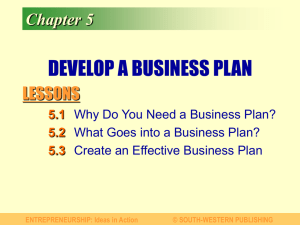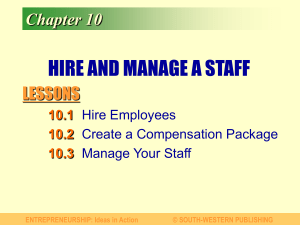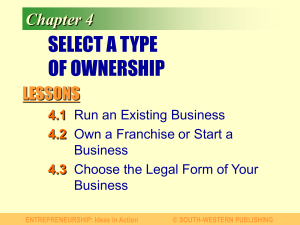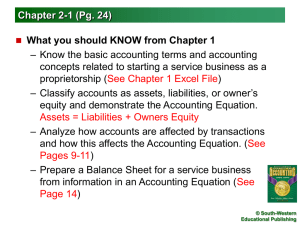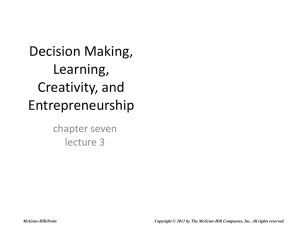Chapter 6 IDENTIFY AND MEET A MARKET NEED
advertisement
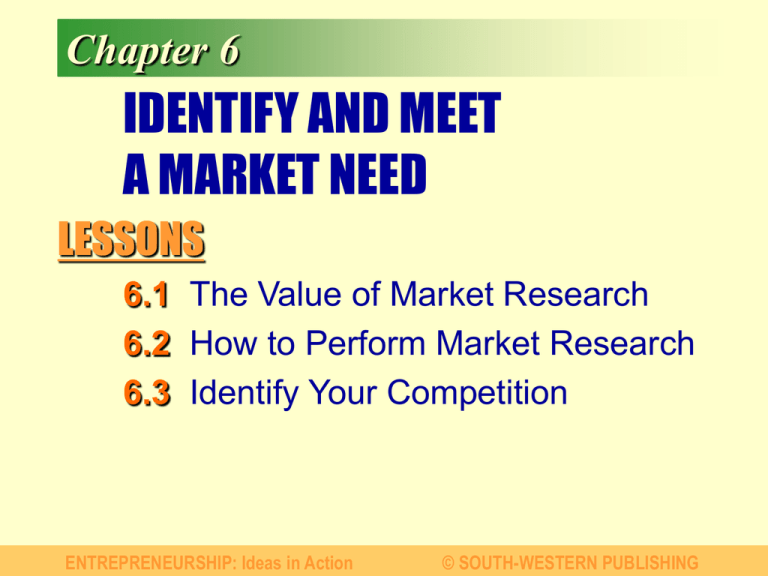
Chapter 6 IDENTIFY AND MEET A MARKET NEED LESSONS 6.1 The Value of Market Research 6.2 How to Perform Market Research 6.3 Identify Your Competition ENTREPRENEURSHIP: Ideas in Action © SOUTH-WESTERN PUBLISHING Chapter 6 Slide 2 Lesson 6.1 THE VALUE OF MARKET RESEARCH GOALS Identify a target market by understanding your customers. Research your market using primary and secondary data. ENTREPRENEURSHIP: Ideas in Action © SOUTH-WESTERN PUBLISHING Chapter 6 Slide 3 WHAT IS A TARGET MARKET? The target market is the individuals or companies that are interested in a particular product or service and are willing and able to pay for it. The marketing concept uses the needs of customers as the primary focus during the planning, production, distribution, and promotion of a product or service. ENTREPRENEURSHIP: Ideas in Action © SOUTH-WESTERN PUBLISHING Chapter 6 Slide 4 UNDERSTAND YOUR CUSTOMER Customers are the people who buy the products and services companies offer. Customers buy goods and services to satisfy economic wants and needs. An economic want is an unfilled desire of a customer. An economic need is anything that is required to live. ENTREPRENEURSHIP: Ideas in Action © SOUTH-WESTERN PUBLISHING DEMOGRAPHICS AND PSYCHOGRAPHICS Chapter 6 Slide 5 Demographics are data that describe a group of people in terms of their age, marital status, family size, ethnicity, gender, profession, education, and income. Psychographics are data that describe a group of people in terms of their tastes, opinions, personality traits, and lifestyle habits. ENTREPRENEURSHIP: Ideas in Action © SOUTH-WESTERN PUBLISHING Chapter 6 Slide 6 IDENTIFY YOUR TARGET MARKET 1. Who are my customers: individuals or companies? 2. If customers are individuals: How old are they? How much money do they earn? Where do they live? How do they spend their time and money? 3. If customers are companies: What industries are they in? Where are those industries located? ENTREPRENEURSHIP: Ideas in Action © SOUTH-WESTERN PUBLISHING Chapter 6 Slide 7 continued IDENTIFY YOUR TARGET MARKET 4. What needs or wants will my product or service satisfy? 5. How many potential customers live in the area in which I want to operate? 6. Where do these potential customers currently buy the products or services I want to sell them? 7. What price are they willing to pay for my products or services? 8. What can I do for my customers that other companies are not already doing for them? ENTREPRENEURSHIP: Ideas in Action © SOUTH-WESTERN PUBLISHING THE IMPORTANCE OF A CUSTOMER PROFILE Chapter 6 Slide 8 A customer profile is a description of the characteristics of the person or company that is likely to purchase a product or service. ENTREPRENEURSHIP: Ideas in Action © SOUTH-WESTERN PUBLISHING Chapter 6 Slide 9 MARKET SEGMENTS Groups of customers within a large market who share common characteristics are known as market segments. ENTREPRENEURSHIP: Ideas in Action © SOUTH-WESTERN PUBLISHING Chapter 6 Slide 10 UNDERSTAND THE COMPETITION Knowing about your competition will help you define your target market. ENTREPRENEURSHIP: Ideas in Action © SOUTH-WESTERN PUBLISHING Chapter 6 Slide 11 MARKET RESEARCH Market research is a system for collecting, recording, and analyzing information about customers, competitors, goods, and services. Market researchers collect primary and secondary data. ENTREPRENEURSHIP: Ideas in Action © SOUTH-WESTERN PUBLISHING Chapter 6 Slide 12 SECONDARY DATA Secondary data is data found in already published sources. ENTREPRENEURSHIP: Ideas in Action © SOUTH-WESTERN PUBLISHING Chapter 6 Slide 13 PLACES TO FIND SECONDARY DATA Publications issued by government and community organizations, such as the U.S. Census Bureau, the Small Business Administration, and Chamber of Commerce Books about specific industries Information on web sites for government and businesses Books about other entrepreneurs who set up similar businesses Specialized magazines and journals devoted to particular fields Newspaper articles and statistics ENTREPRENEURSHIP: Ideas in Action © SOUTH-WESTERN PUBLISHING Chapter 6 Slide 14 PRIMARY DATA Primary data is information collected for the very first time to fit a specific purpose. Questionnaire or survey Observation Focus groups Disadvantage of primary data ENTREPRENEURSHIP: Ideas in Action © SOUTH-WESTERN PUBLISHING Chapter 6 Slide 15 Lesson 6.2 HOW TO PERFORM MARKET RESEARCH GOALS Identify the five steps involved in primary data market research. Design a questionnaire. ENTREPRENEURSHIP: Ideas in Action © SOUTH-WESTERN PUBLISHING FIVE STEPS OF PRIMARY MARKET RESEARCH Chapter 6 Slide 16 Define the question Select a research method Collect data Analyze data Draw conclusions ENTREPRENEURSHIP: Ideas in Action © SOUTH-WESTERN PUBLISHING Chapter 6 Slide 17 DESIGN A SURVEY Length of questionnaire Questions Clear Easy to answer Only important questions ENTREPRENEURSHIP: Ideas in Action © SOUTH-WESTERN PUBLISHING Chapter 6 Slide 18 Lesson 6.3 IDENTIFY YOUR COMPETITION GOALS Determine your direct and indirect competition. Analyze the strengths and weaknesses of competitors. Establish strategies for maintaining customer loyalty. ENTREPRENEURSHIP: Ideas in Action © SOUTH-WESTERN PUBLISHING DIRECT AND INDIRECT COMPETITION Chapter 6 Slide 19 Direct competition is competition from a business that makes most of its money selling the same or similar products or services as another business. Indirect competition is competition from a business that makes only a small amount of money selling the same or similar products or services as another business. Find your direct competition Find your indirect competition ENTREPRENEURSHIP: Ideas in Action © SOUTH-WESTERN PUBLISHING COMPETING WITH LARGE BUSINESSES Chapter 6 Slide 20 Large retailers usually are able to keep larger quantities of products in stock. Large retail chains don’t rely on one single product line. Large companies usually have more resources to devote to advertising. ENTREPRENEURSHIP: Ideas in Action © SOUTH-WESTERN PUBLISHING Chapter 6 Slide 21 STUDY INDIVIDUAL COMPETITORS Price Location Facility Strengths Weaknesses Strategy ENTREPRENEURSHIP: Ideas in Action © SOUTH-WESTERN PUBLISHING STRATEGIES FOR MAINTAINING CUSTOMER LOYALTY Chapter 6 Slide 22 Listen and respond to feedback Other strategies for maintaining loyalty Superior service More convenient hours than other businesses Easy return policies Store-specific credit cards Personal notes or cards Frequent buyer programs ENTREPRENEURSHIP: Ideas in Action © SOUTH-WESTERN PUBLISHING
